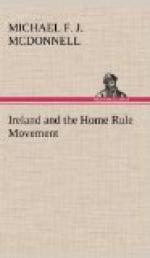another instance of the reliability which is a characteristic
of the Irish peasant. This brings one to note
in passing that of all others the fishing industry
has probably suffered most from the lack of proper
means of transit. The 2,500 miles of coast line
offer great scope, but the catch of fish off the Irish
coast is only one-eighth of that off Scotland, and
one-sixteenth of that off England and Wales, and Irish
waters are to a very large extent fished by boats
from the coasts of Scotland, the Isle of Man, France,
and Norway. Oyster fisheries used to abound—the
celebrated beds at Arcachon in the Landes were stocked
from Ireland—but they have fallen into disuse,
and with their disappearance a very remunerative business
has been lost. The need for extensive and scientific
forestry one may also note is obvious, from the fact
that there are seven million acres of former woodland
which are now reduced to a waste. The results
of planting a shelter bed of pines on the north and
west coasts, as a protection from the Atlantic winds,
would be very great, while the industrial effect of
systematised forestry would be immense. Bark
for tanning, charcoal, moss, resin, manure from fallen
leaves, litter, fuel, and mushrooms are some of the
bye-products of this reproductive industry, while by
planting willows, which yield a rapid return, along
bogs a basket weaving industry might very rapidly
be developed. The need, however, for planting
on an extensive scale and the inevitable delay before
any returns for expenditure accrue, make forestry
essentially an object not for private but for public
enterprise.
It is not generally known that in 1831 Ireland grew
one-fifth of the tobacco consumed in the three kingdoms,
but that in that year the first Liberal Government
which was in power for a generation put down a profitable
industry for which the turfy soil of the country was
particularly well adapted. With the help of a
shilling rebate it is being shown, on an experimental
area, that tobacco can be grown successfully in Ireland.
At present the Treasury has refused to allow any extension
of the area under cultivation, and it remains to be
seen whether the united demands of Irish members—Unionist
as well as Nationalist—will secure the
removal of the prohibition against its growth, and
so possibly lead to a re-establishment of its cultivation
on a similar scale to that of three-quarters of a
century ago.
Perhaps the most important and, one may surmise, far-reaching
step which has been taken in respect of Irish industries
in the last few years is to be found in the registration,
under the Merchandise Marks Act of 1905, of a national
trade-mark, the property in which is vested in an
association, which, on payment of a fee, grants the
right to use it to manufacturers of the nature of
whose credentials it is satisfied. The value
of this is obvious as giving a guarantee of the country
of origin of goods at a time when the increased demand




